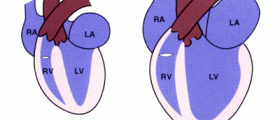
There are two groups of blood vessels that carry blood from the heart. One group transports oxygen-depleted blood from the right ventricle of the heart to the lungs and it is known as the pulmonary or lung circulation. The other set of blood vessels carries oxygenated blood from the right left ventricle of the heart to the rest of the body and is called the systemic circulation. Blood vessels of the pulmonary vasculature are the pulmonary arteries, pulmonary veins and pulmonary capillaries. Elevated pressure in the pulmonary arteries leads to pulmonary hypertension.
Pulmonary Hypertension Overview
Normally, the pressure in the pulmonary circulation is considerably lower than the pressure in the systemic circulation. However, when pulmonary blood vessels become stiff and narrow, the pressure within the arteries of the lungs increases. This causes the right ventricle of the heart to pump harder than normal which can cause it to expand and result in accumulation of fluid within the liver, lungs and other body tissues.
Pulmonary hypertension also known as pulmonary artery hypertension or PAH can have many causes. The condition causes the heart to weaken and may lead to heart failure.
The process by which pulmonary hypertension develops often includes more than one mechanism. It can occur due to low oxygen levels in the blood (hypoxia) associated with sleep apnea, chronic obstruction pulmonary disease (COPD) and other conditions. A blood clot in the lung (tromboembolic disease) can also lead to pulmonary hypertension.
Left heart diseases such as mitral stenosis, aortic stenosis, constrictive pericarditis, restrictive cardiomyopathy and dilated cardiomyopathy can cause pulmonary hypertension. Different lung conditions are also often responsible for pulmonary hypertension. These diseases include scleroderma, interstitial disease, asthmatic bronchitis, cystic fibrosis and emphysema.
Pulmonary hypertension may develop due to certain medications that cause constriction of the blood vessels. This includes anti-obesity medications such as dexfenfluramine and Fen/Phen, and illicit drugs such as cocaine and methamphetamines. Schistosomiasis, the parasitic infection that causes obstruction of the arteries in the lungs can also lead to pulmonary hypertension.
Sometimes, pulmonary hypertension is idiopathic, meaning there is no known cause of the condition.
Symptoms of Pulmonary Hypertension
Symptoms of pulmonary hypertension develop gradually. Primary symptom of pulmonary hypertension is shortness of breath and lightheadedness during everyday activities. However, as the disease progresses this symptom occurs even at rest. Palpitations or fast heart rate, racing pulse and chest pain are also associated with pulmonary hypertension. Other symptoms include fatigue, weakness, dizziness, fainting spells, swelling in the abdomen, ankles or legs and bluish color of the skin and lips (cyanosis).

















Your thoughts on this
Loading...